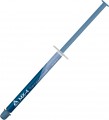Type
—
Thermal paste. Thermal interface in the form of a thick substance applied to the “hot” elements of the computer motherboard to ensure the necessary thermal conductivity. Thermal paste contains various heat-conducting components from nanodispersed powders and mixtures, and liquids with a low level of volatility of synthetic or mineral origin are usually used as its thickener.
-
Liquid metal. Liquid metal consists of alloys with a high level of fluidity (zinc, gallium, tin, etc.). Its competitive advantage is a much higher level of thermal conductivity (7-9 times higher than that of conventional thermal paste). Also, liquid metals retain their properties over a wide temperature range from -273 °C to +1200 °C. The other side of the coin when using liquid metals is the complexity of application and removal, the inability to use with aluminum radiators, and the electrical conductivity of the material (any contact of the thermal interface with open contacts can cause a short circuit).
—
Thermal pad. Thermal pads are elastic soft sheets of silicone (or other similar material) impregnated with heat-conducting particles - aluminum oxide, boron nitride, etc. They are designed to ensure proper heat transfer between components on the computer motherboard that may not be pressed tightly together. Thermal pads compensate for gaps and unevenness in large areas and
...in complex structures. They differ from each other in thickness, filling, number of layers and adhesive surfaces.
— Liquid thermal pad. A paste-like substance similar to thermal paste, but thicker. After application and hardening, it forms an elastic thermal pad, effectively filling all the gaps between the surfaces of elements on the motherboard. The liquid state of such a thermal interface allows you not to bother with selecting gaskets of the required thickness.Package
— a href="/list/247/pr-47871/">Syringe. The most convenient packaging for thermal paste. Due to the fact that air does not penetrate into the closed syringe, the paste is stored in it for a long time. From a syringe, it is easy to apply and accurately dose thermal grease.
—
Tube. A soft tube for pasta, from which the contents are extracted by squeezing. For spot application, tubes are less suitable than syringes, but as a packaging for long-term storage of thermal paste, they are excellent.
—
Jar. A container in the form of a small jar in which it is convenient to store the thermal interface. To apply the paste directly from the jar, you will need to have a spatula or applicator brush on hand.
Size
Knowing the dimensions of the thermal pad, you can evaluate how it will suit certain tasks. A thermal interface is cut out the size of a chip or with a small margin.
Items in set
The total number of thermal pads in the set.
Sets of several pieces are cheaper in terms of one thermal interface, but the need for them arises infrequently. For isolated cases of replacement of thermal pads, one copy in a set will be quite enough.
Area
The area of contact between the thermal pad and the chip surface, measured in square centimeters (cm²).
Thickness
Thermal pads are usually selected in
thickness according to the width of the measured gap plus 0.1 - 0.5 mm to provide the necessary pressure, taking into account the deformation of the gasket material. If the thermal rubber is smaller than the gap between the heatsink and the chip, you can use several spacers together to achieve the required thickness.
Weight
Product net weight (without packaging). Knowing the amount of thermal paste in the packaging, you can estimate how much it will last.
Thermal conductivity
The fundamental indicator for pasta. The parameter determines the amount of heat passing through a unit of substance during a unit of time. The higher the thermal conductivity of thermal paste, the better. For home computer processors that do not get very hot, in principle, any thermal conductivity is suitable, but for high-performance gaming stations, it is advisable to give preference to compositions with high thermal conductivity (from 5 W / mK and more).
Viscosity
Thickness of thermal paste. The viscosity of the paste is considered to be optimal in the range of 160–450 poise. By eye, the consistency should be slightly thicker than that of hand cream or toothpaste. Too liquid thermal paste during operation can leak out under its own weight, too thick — it will not be able to fill the microcracks on the surface of the processor and heatsink as much as possible.

